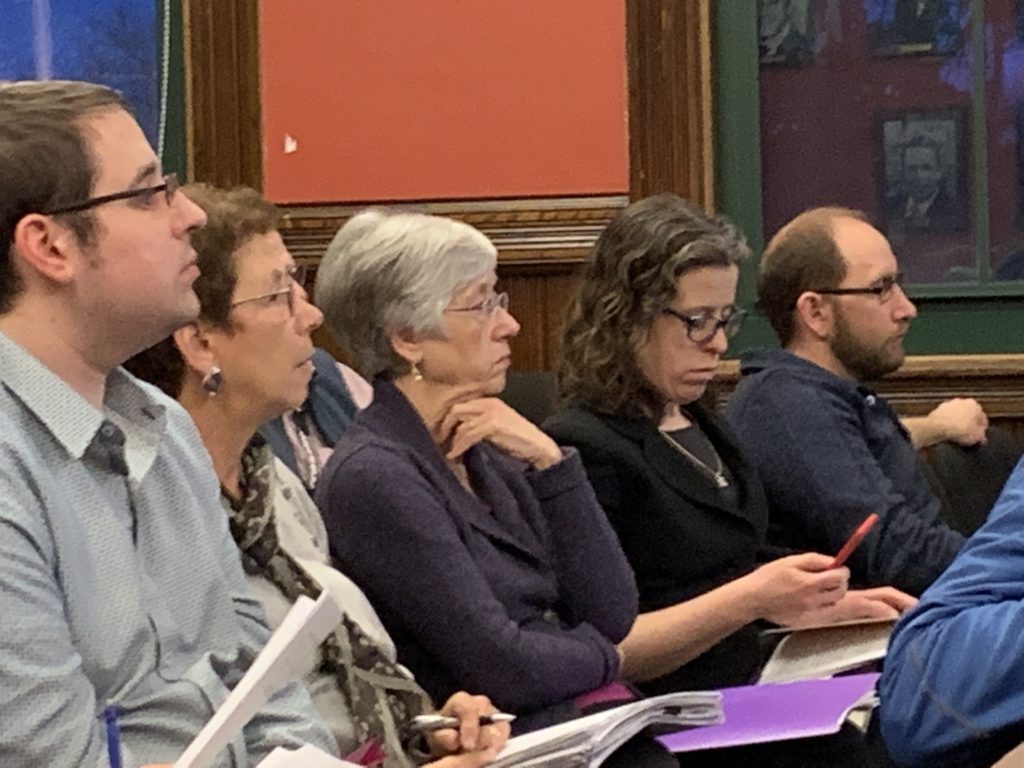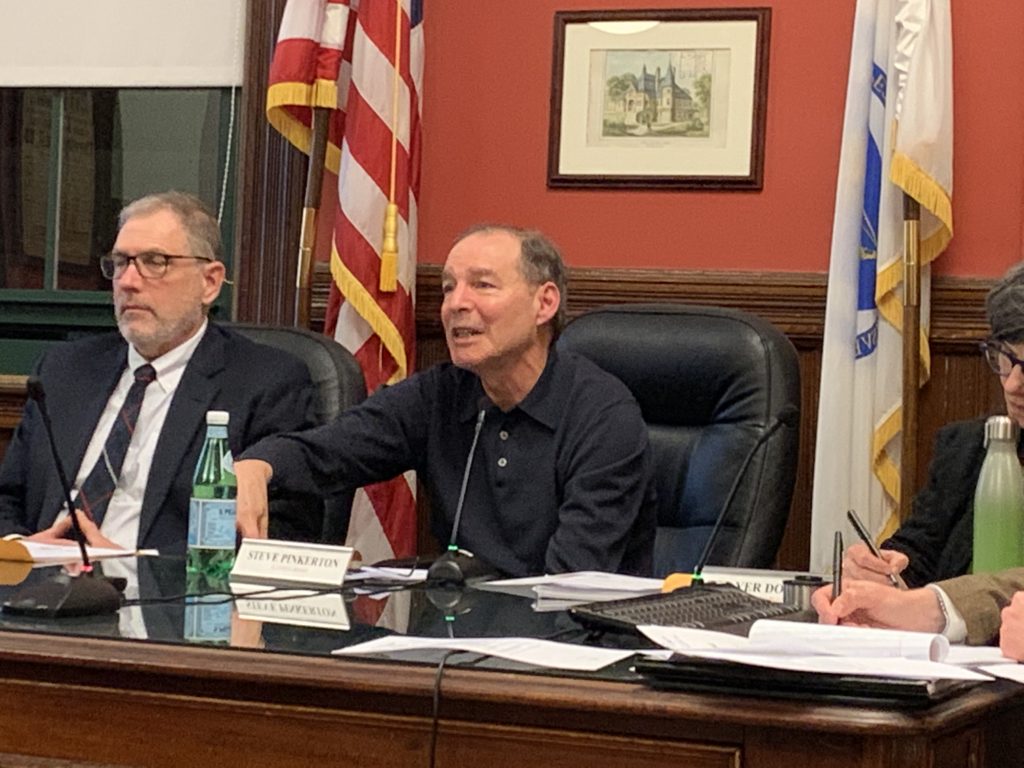Photo: The Planning Board in session.
A proposed 125 unit residential development on one of the last large parcels of open space in Belmont was shelved by the Belmont Planning Board as questions of affordability, density and other issues were raised by residents and board members.
“We don’t have the time” to satisfactory review the proposal before a Town Meeting vote, said Board Chair Chuck Clark at the Thursday, March 14 meeting as the board voted unanimously to not bring six bylaw changes to the town’s annual legislative gathering.
The postponement is a victory for affordable housing campaigners who contend the McLean Hospital Zone 3 project is the one best and likely final opportunities to bring a substantial number of accessible units into the town’s housing inventory.
“Let’s slow this down so we all can get to and work together,” said Rachel Heller, co-chairman of the Belmont Housing Trust, which has been advocating for greater income diverse housing through public policy – securing the town’s Housing Production Plan – and with growing activism.
The delay is a blow to property owner McLean Hospital and Northland Residential, the proposed developer, which were seeking a positive vote at the annual Town Meeting in May to expedite the construction of what a Northland executive called an “age directed” project on nearly 13 acres of land set aside for housing when Town Meeting approved a mixed-use development plan with McLean nearly two decades ago in July 1999.
While the proponents pointed to the success of the nearby Northland-developed The Woodlands as being replicated on Zone 3, board vice chair Stephen Pinkerton said: “there are a lot of issues in terms of density and interest in affordable housing that need to be vetted among a half a dozen entities in town.”
“This won’t pass [Town Meeting] by a two-thirds majority” as Pinkerton motioned to the residents filling the Selectmen’s Room, suggesting the process be “paused.”
Clark told the Belmontonian the Planning Board will ask the Belmont Board of Selectmen to create a task force with “everybody” including the Housing Trust, residents in addition to McLean “to figure this out.”
“I see this come back to Town Meeting in the fall,” said Clark, referring to an anticipated Special Town Meeting that typically takes place in November. “I suspect we’ll come to an agreement, it will just take a while.”
While campaigners did not have specific numbers or percentages of units, advocates said they are available to assist McLean and Northland either by introducing established affordable developers to partner with the proponents or work independently.
“A task force will create the opportunity for all these voices to be heard and then really think how to develop something that’s beneficial for McLean meets the town’s needs,” said Heller.
The question now hanging over the stalled development is if McLean and Northland will accept a new round of negotiations that could result in a greater affordability component.
McLean and the developer both noted in their presentations Thursday night the nearly 13 acres is currently zoned to accommodate approximately 500 apartment-style units in a high-density complex that includes buildings upwards to six stories tall and generating considerable vehicle traffic.
But it’s unlikely McLean would go that route and the developer admitted the “bankability” of such large assisted living/care complexes has waned considerably in the past decade.
The development – located on the southern ridge of the hospital close to Star Market and Pleasant Street – would be a “senior directed independent living residential community” consisting of 34 large 2 to 3 bedroom townhouses with a sales price of upwards of $1.5 million similar to those in the adjacent Woodlands along with 91 “flat” 1 to 2 bedroom apartments located in four-story buildings. The complex would provide town coffers with $1.6 million in added tax revenue.
Under a revised plan, 20 apartments would be designated “affordable” for those making 80 percent of the area median income (for a two-person family, an 80 percent AMI would be $63,050), an increase from a proposed 9 units that target buyers with an AMI as high as 120 percent ($94,550 for a two-family household).
When the meeting was thrown open to public comment, it was quickly evident that despite a doubling of the number of affordable units in Zone 3, housing advocates felt, as Heller noted, “we can do a lot better.”
With Belmont still 337 units short of the state’s goal of 10 percent affordable housing. McLean is “one of the few if the only way for the town to get to that 10 percent,” said Heller, who said that rather than townhouses, the community needs more rental units as more than 40 percent of Belmont renters are “cost-burdened” as housing costs take more than a third of their income.
Gloria Leipzig of the Belmont Housing Authority noted the 40-unit Waverley Woods, designated in the 1999 agreement for low and moderate income housing, was built on 1.4 acres, “eight times” the space being proposed for the Zone 3 development.
“Certainly more than 34 large townhouses and 90 [apartments] can be built on this property,” she said.
Squandering The Potential
As the land was “laid aside for specific community needs,” once a development proposal is adopted, “we can’t take this zoning back,” said Joseph Zarro, pastor of Belmont’s Plymouth Church. “I think we’d be squandering the potential of this land” under the proposed project.”
One resident commented on a statement by a Northland executive who said the new townhouses that would likely sell for $1.5 million was built “for folks that look like me and you.” Elizabeth Lipson of the Housing Trust said she is sensitive to “dog whistle” comments that housing in Belmont should be built with a certain income level in mind.
“One of the objectives of many of us is to diversify our town by income and … also by race,” said Lipson, who found the comment “upsetting.”
Throwing another wrench into the works was a legal ruling brought forth by attorney Roger Colton who noted a 2002 ruling by the state’s Land Court against the town’s Planning Board and Zoning Board of Appeals (American Retirement Corp vs et al) limiting both boards “to make its own interpretation of what was ‘best’ for the town” which should be left “to the legislative process.”
With issues of housing diversity, density and a sticking point that the bylaw changes would benefit the current proposal but not alter the existing zoning map, leaving the possibility of a future developer to build to the approved level of nearly 500 units, Clark said there was no chance the board could resolve any of the outstanding issues by the end of the month.
“There are too many moving parts,” he said.
Nearly lost in the residential development discussion was McLean’s earlier proposal to construct a campus for children and adolescence education and a research and development center on an adjacent parcel located to the northeast. Known as Zone 4, the development will not start for upwards to five years as the hospital raises funds for the project, said Michele Gougeon, McLean’s executive vice president and chief operating officer.
Eventually, the site will include a combined academic and residential building and a “small” Research and Development building which will fit inside a 150,000 sq.-ft. envelop.
Clark noted in past agreements, due to the R&D portion is being reduced by more than half of the original, the town could be obligated to pay McLean for that change, a statement Gougeon said would need to be reviewed.
By the end of the night, Clark believed there will be a solution to the issues face all parties.
“I think McLean can do better. I think Belmont can do better,” said Clark.










Leave a Review or Comment